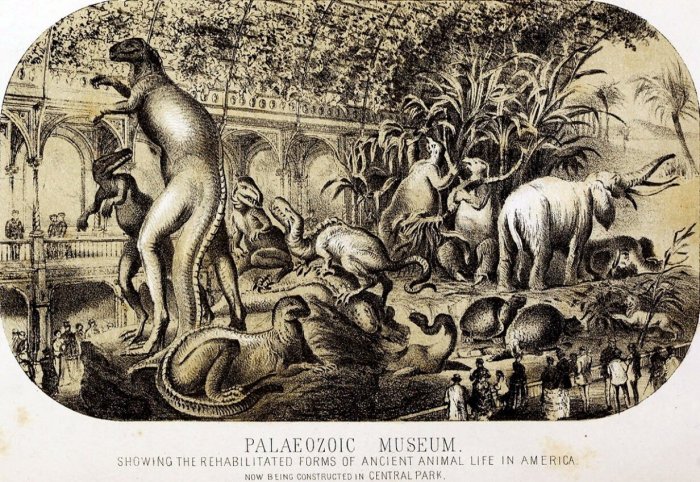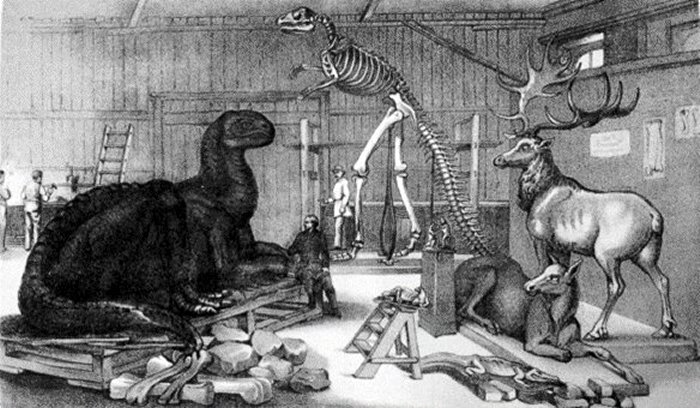Eddie Gonzales Jr. – AncientPages.com – A new paper from the University of Bristol rewrites the history of the darkest, most bizarre event in the history of paleontology.
In New York, in May of 1871, the partially built, life-size models of dinosaurs and other prehistoric creatures destined for a prestigious new museum in Central Park were totally destroyed in a violent act of malicious vandalism by a gang of thugs with sledgehammers. The shattered pieces were carted away and buried somewhere in the park, never to be seen again.

Benjamin Waterhouse Hawkin’s conceptual drawing of the Paleozoic Museum. Credit: Annual report of the Board of Commissioners of the Central Park (1858)
Until now, the heinous act had been attributed to former American politician William “Boss” Tweed.
But now, a new paper from Victoria Coules of Bristol’s Department of History of Art and Professor Michael Benton of Bristol’s School of Earth Sciences sheds new light on the incident and, contrary to previous accounts, identifies who was really behind the order and what drove them to such wanton destruction—an odd man known as Henry Hilton, the Treasurer and VP of Central Park.
“It’s all to do with the struggle for control of New York city in the years following the American Civil War (1861-1865),” said Coules. “The city was at the center of a power struggle—a battle for control of the city’s finances and lucrative building and development contracts.”
As the city grew, the iconic Central Park was taking shape. More than just a green space, it was to have other attractions, including the Paleozoic Museum. British sculptor Benjamin Waterhouse Hawkins, who had created the Crystal Palace Dinosaurs, the life-size models of prehistoric creatures in London—had traveled to America and was commissioned to build American versions of the models for the Paleozoic museum.

Benjamin Waterhouse Hawkins’ studio at the Central Park Arsenal, with models of extinct animals. Credit: 12th Annual Report of the Board of Commissioners of the Central Park for the Year Ending December 31, 1868
But the notorious William “Boss” Tweed had taken command of the city and, in sweeping changes to the city’s governance, put his own henchmen in charge of city departments—including Central Park. They canceled the partially complete project in late 1870, and there the matter would have lain but in May 1871 someone ordered the gang of workmen to destroy all of its partly finished contents.
Professor Benton explains, “Previous accounts of the incident had always reported that this was done under the personal instruction of ‘Boss’ Tweed himself, for various motives from raging that the display would be blasphemous, to vengeance for a perceived criticism of him in a New York Times report of the project’s cancelation.”
“Reading these reports, something didn’t look right,” Coules said. “At the time Tweed was fighting for his political life, already accused of corruption and financial wrong-doings, so why was he so involved in a museum project?” She added, “So we went back to the original sources and found that it wasn’t Tweed—and the motive was not blasphemy or hurt vanity.”
The situation was complicated by two other projects in development at the same time in Central Park, the American Museum of Natural History (AMNH) and the Central Park Zoo. But, as Professor Benton explained, “drawing on the detailed annual reports and minutes of Central Park, along with reports in the New York Times, we can show that the real villain was one strange character by the name of Henry Hilton.”
Coules adds, “Because all the primary sources are now available online, we could study them in detail—and we could show that the destruction was ordered in a meeting by the real culprit, Henry Hilton, the Treasurer and VP of Central Park—and it was carried out the day after this meeting.”
Hilton was already notorious for other eccentric decisions. When he noticed a bronze statue in the Park, he ordered it painted white, and when a whale skeleton was donated to the American Museum of Natural History, he had that painted white as well. Later in life, other ill-judged decisions included cheating a widow out of her inheritance, squandering a huge fortune, and trashing businesses and livelihoods along the way.
Professor Benton concluded, “This might seem like a local act of thuggery but correcting the record is hugely important in our understanding of the history of paleontology. We show it wasn’t blasphemy, or an act of petty vengeance by William Tweed, but the act of a very strange individual who made equally bizarre decisions about how artifacts should be treated—painting statues or whale skeletons white and destroying the museum models. He can be seen as the villain of the piece but as character, Hilton remains an enigmatic mystery.”
The study is published in the journal Proceedings of the Geologists’ ᴀssociation.
Written by Eddie Gonzales Jr. – AncientPages.com – MessageToEagle.com Staff





